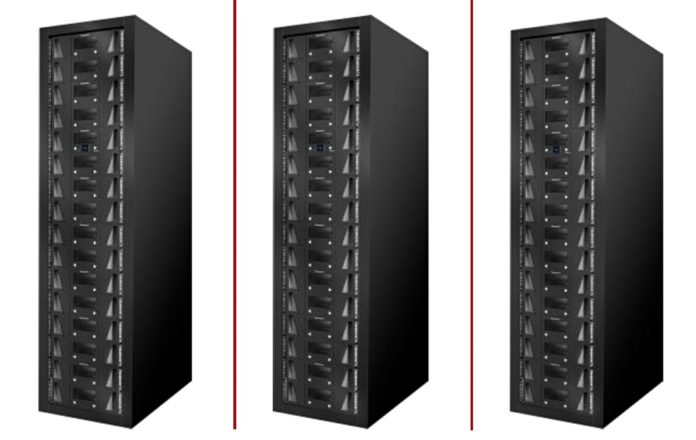Oh, it turns out Quantum’s success in selling tape libraries to three of the top hyperscalers is due to specially developed scale-out and modular tape libraries and object software.

In August it said it was engaged with six of the top ten hyperscalers, either in production or in product trials. During an IT Press Tour online briefing yesterday Eric Bassier, Quantum’s senior director for product marketing, said: “Three of the world’s biggest hyper scalers, three of the top five, use Quantum in production. Predominantly, they’re using Quantum tape. … And we also have an initial tape footprint deployed at the other two … in a proof of concept stage.”
It’s also expanding to a tier of customers one down from the hyperscalers: “This last quarter, we added three design wins and I would call them international web scale companies. So these are not in the top 10 but they’re in the top 100. … One of these customers is a popular social media video sharing application.Our initial footprint is a two exabyte archive that combined StorNext 7 software with Quantum tape in a RAIL configuration as this massive video archive for all of their content.”
RAIL is Quantum’s Redundant Array of Independent Libraries concept, a RAID-like scheme providing increased scale, protection and performance. A second webscale client has a 1.3EB initial deployment.
The company has a Scalar line of tape library products:
- i3 with 25 to 400 tapes and 18PB compressed capacity with LTO-9 media;
- i6 with 50 to 800 tapes and 136PB of maximum compressed capacity;
- i6000 with 100 to 12,000 tapes and 540PB of compressed capacity in 21 racks.

These are scale up or monolithic libraries. Bassier believes that the hyperscaler tape wins are unlikely to use these products, and he may be right.
He said: ”We’ve done a lot of custom engineering work to make our tape systems designed for archives at that scale. This is really hardware-based engineering. And there are capabilities and there are actually even models of tape systems that we sell into this market that we do not have on our web site today.”
Scalability
What scale is that? One International webscale customers was said to have a two-exabyte archive — that would require four Scalar i6000 libraries to reach that level. We can imagine that the hyperscaler customers have multi-exabyte configurations. A 10EB deployment would need almost twenty i6000s and more than 400 racks. That sounds unwieldy and it would be ridiculously complex to manage twenty separate monolithic llibraries.

During the briefing Bassier said: “We have a model of tape library today that we don’t have on our web site that has better densities than anything that we show on our web site. And … that’s the model that we’re selling to some of these large hyperscalers.”
So Quantum has a Scalar iSomething that is denser, meaning more media in less space, than the i6000. He said more: “If someone were to purchase ActiveScale cold storage, we would deploy this tape system as part of delivering that.”
It’s also scalable out to … well, 10EB and beyond, we think. Well beyond, because the hyperscalers could keep cold data for five years, possibly ten, possibly even more, and they just keep on accumulating it. Are we heading for 100EB archives?
Front-end management
The ActiveScale scheme has an S3-accessed front-end tier of active data storage using disk for data and flash for metadata, and a back-end cold tier, S3 Glacier-class storage, using objects written to tape in 1TB chunks and using erasure coding.
This cold tier has multiple libraries in the RAIL scheme. It also uses dynamic data placement, with the ActiveScale software mapping an object’s name to a particular tape in a particular library. This is not an object content-addressed hashing scheme with objects stored in a ring of systems, like the Scality RING. Instead think of it as a quasi-single-level file:folder scheme, with the folder containing mapping information to link object names to their addresses in the RAIL system.
In a way, Quantum has invented away of clustering tape libraries behind the ActiveScale front-end system, making its monolithic libraries kind of modular through clustering. The new tape library hardware it has developed will be natively modular, we expect.
The ActiveScale system provides a single pane of glass for managing a cluster of modular libraries — that would solve the problem of managing multiple separate libraries — and Quantum’s CatDV software is set to be developed into a content indexing scheme for them.
We can expect more information to be revealed fairly soon, as Bassier said: ”We’re going to have a lot more news around tape this quarter.”
Quantum said the hyperscale (and webscale) tape market is set for growth. It has more than 30EB of deployed capacity in these two markets already and reckons it is the runaway leader. Possibly other tape library vendors, such as IBM, HPE and Spectra Logic, will also follow the modular library route.








